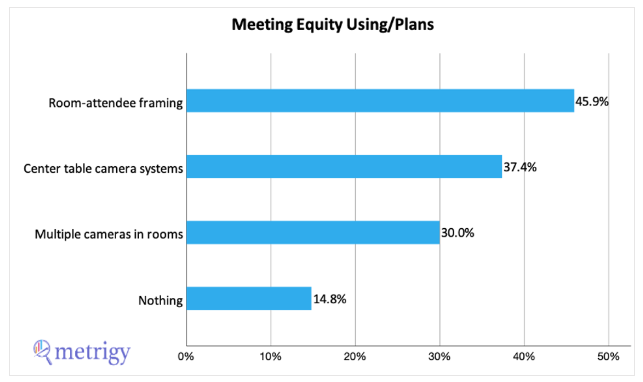Balancing the experience of virtual and in-person meeting participants is a top-of-mind issue for many business leaders as they hone their hybrid work strategies and technology plans around building a collaborative work environment. Video meeting application and equipment providers are giving them lots of options.
Culled from products announced or on display at the recent Enterprise Connect 2023, here’s a look at how come providers are furthering the state of the art for hybrid, collaborative workforces.
Meeting spaces, intelligently defined – From Metrigy’s global “Employee Experience & Workplace Engagement 2022-23” research study, we know most companies already place high value on artificial intelligence (AI)-driven video meeting functions. More than half of 250 participating companies consider in-meeting voice assistance and content search to be of high value, with 48.4% indicating the same of speaker identification. These types of capabilities are great starting points, but providers are now getting even more innovative on how they use AI to improve the meeting experience.
A prime example comes from Cisco, which introduced a feature its calls “meeting zones.” This capability gives IT the ability to set virtual boundaries for in-office collaboration spaces, essentially turning them into areas for meeting with remote colleagues without distraction. The AI technology individually frames in-office meeting participants in a condensed view so that virtual attendees see only them and nothing or nobody outside the defined meeting zone. This is a bit hard to visualize but try to imagine an open office environment with a corner virtually cordoned off for team meetings.
Meeting equity – Meeting equity technologies enhance remote attendee experience by improving visibility of in-room meeting participants. Room-attendee framing, center table camera systems, and using multiple cameras in rooms are three options for equalizing the meeting experience for in-person and remote meeting attendees. Metrigy’s recent “Workplace Collaboration: 2023-24” global research study found that almost 46% of 440 participating companies are planning to use speaker framing, as shown in the chart below.
Cisco plays here too, with the introduction of a cinematic meetings capability available with its its collaboration devices. With cinematic meetings, in-room cameras follow in-room meeting participants using voice and facial recognition and automatically switch views to deliver the best angle of the active speaker for remote participants. Similarly, HP announced support for multi-room camera systems for more effective framing of in-room participants for visibility to remote attendees.
Virtual coworking – Some collaboration application vendors strive to deliver products that mimic the in-office experience of running into or working alongside colleagues for a hybrid workforce. Zoom is tackling this challenge via a video-oriented virtual coworking product called Huddles, aimed at enabling quick, free-form conversations, primarily by video. From within the Zoom desktop client, employees can view available Huddles, and click to join a discussion. This is similar to the spur-of-the-moment meeting capability Slack has been offering in its team collaboration app, also using the “huddle” designation. In Slack’s case, the huddle option appears within channels and direct messages, offering employees the opportunity to open a audio or video chat rather than having a text interaction. Radisys, another vendor aiming to facilitate informal ad-hoc conversations, is taking an audio-only approach. It showcased its social audio tool, called Impromptu, at Enterprise Connect.
As these examples show, rethinking the meeting space and the proverbial watercooler are very much goals of collaboration vendors as look to differentiate their offerings for a collaborative hybrid workforce. Enterprise IT and other business leaders should look beyond basic capabilities to craft an experience that will truly support virtual collaboration and keep employees engaged.







